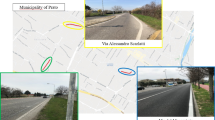Abstract
Roads are the largest component of infrastructure; they directly impact people’s life by providing mobility and connectivity. To ensure consistent surface quality, roads must be monitored continuously and repaired when necessary. Presently, authorities spend substantial amount of time, finance and labor for pavement distress detection by employing traditional manual and instrumented methods which are generally tedious, and time-consuming. To overcome these drawbacks, various automated techniques like Ground Penetrating Radar, Laser-Imaging-Systems, etc. are deployed. Recently, image-processing and smartphone-based systems are being devised for pavement distress detection. Here, a vibration-based method using smartphone accelerometer and gyroscope, and a vision-based method using video processing for automated pavement distress detection are designed and compared to identify the more suitable one. Both experiments are performed on same roads and results are validated by manual surveying. Accuracy of vibration-based method for detecting potholes, patches and bumps is found as 80%. Accuracy for detecting cracks, potholes and patches using vision-based method is identified as 84%. An additional effort is taken to estimate the extent of pavement distresses using vision-based approach and validate it using manual stripping method. The study reveals that, vibration-based-analysis is sufficient for routine monitoring purposes whereas vision-based-method is more appropriate for detailed analysis.
Similar content being viewed by others
References
Ministry of Road Transport & Highways, Annual Report 2017–18-, MoRTH, Government of India, New Delhi, India, 2018
NCHRP, Guide for Mechanistic-Emperical Design of new and rehabilitated Pavement structures. 1–37 A. ERES Consultants Division, Champaign, IL, USA, 2004
Federal Highway Administration, Pavement distress identification manual for the NPS Road Inventory. Cycle 4 2006–2009, FHWA, Washington DC, USA, 2009.
G. Bao, Road Distress Analysis using 2D and 3D Information, (Doctoral Dissertation), University of Toledo, Toledo, OH, USA, 2010.
W. Ouyang, B. Xu, Pavement cracking measurements using 3D laser-scan images, Measurement Sci. Technol. 24 (10) (2013) 105204.
W. Wai-Lok Lai, X. Derobert, P. Annan, A review of Ground Penetrating Radar application in civil engineering: A 30-year journey from Locating and Testing to Imaging and Diagnosis, NDT E Inter. 96 (2018) 58–78.
J.M. Neeft, Multimodal Map Matching with smartphone data: a shortest path approach, (Master Thesis), University of Twente, Enschede, Netherlands, 2017.
S. Nawaz, C. Mascolo, Mining users’ significant driving routes with low-power sensors, Proc. 12th ACM Conf. Embed. Netw. Sens. Syst. - SenSys 14, 2014, pp. 236–250.
P. Prasanth, U. Karthikeyan, Effective Tracking of Misbehavioral Driver & Over Speed Monitoring with Emergency Support, Int. J. Adv. Res. Comput. Eng. Technol., 5 (10) (2016) 2527–2529.
S. V Wunnava, K. Yen, T. Babij, R. Zavaleta, R. Romero, C. Archilla, Travel Time Estimation Using Cell Phones for Highways and Roadways, Transp. Res. Board, FL, USA, 2007.
B. S. Yoo, C.-H. Park, S. P. Kang, Travel Time Estimation Using Mobile Data, Proc. East. Asia Soc. Transp. Study 5 (2005) 1533–1547.
A. Sharma, S. Ahuja, M. Gautam, S. Kaul, Smartphone Audio Based Distress Detection, Audio, Speech, and Language Processing. S B/S3/EECE/019/2013. DST-SERB, Government of India, Grant, India, 2013.
C. Kyriakou, S. Christodoulou, L. Dimitriou, Roadway Pavement Anomaly Classification Utilizing Smartphones And Artificial Intelligence, 18th Mediterranean Electrotechnical Conference (MELECON), Limassol, Cyprus, 2016.
J. Eriksson, L. Girod, B. Hull, R. Newton, S. Madden, H. Balakrishnan, The Pothole Patrol: Using a Mobile Sensor Network for Road Surface Monitoring, 6th international conference on Mobile systems, applications, and services, Breckenridge, CO, USA, 2008.
K. De Zoysa, C. Keppitiyagama, G. P. Seneviratne, W. W. A. T. Shihan, A Public Transport System Based Sensor Network for Road Surface Condition Monitoring, Workshop on Networked systems for developing regions, Kyoto, Japan, 2007.
P. Mohan, V. N. Padmanabhan, R. Ramjee, Nericell: Rich Monitoring of Road and Traffic Conditions using Mobile Smartphones, 6th ACM conference on Embedded network sensor systems, Raleigh, NC, USA, 2008..
C. Kyriakou, S. E. Christodoulou, L. Dimitriou, Smartphone-Based Pothole Detection Utilizing Artificial Neural Networks, J. Infrastruct. Syst. ASCE 25 (3) (2019) 1–8.
A. Georgopoulos, A. Loizos, A. Fiouda, Digital Image Processing as a tool for pavement distress evaluation, J. Photogramm. Remote Sens. 50 (1) (1995) 23–33.
T. Ho, C. Chou, C. Chen, J. Lin, Pavement distress image recognition using k-means and classification algorithms, International Conference on Computing in Civil and Building Engineering, Nottinham, UK, 2010.
A. Ouyang, C. Luo, C. Zhou, Surface distresses detection of pavement based on digital image processing, International Conference on Computer and Computing Technologies in Agriculture. Springer, Berlin, Heidelberg, 2010, pp. 368–375.
S. Nienaber, M. Booysen, R. Kroon, Detecting Potholes Using Simple Image Processing Techniques and Real-World Footage, 34th Southern African Transport Conference (SATC), Pretoria, SA, 2015, pp. 153–164.
K. Vigneshwar, B. Hema Kumar, Detection and counting of pothole using image processing techniques, 2016 IEEE International Conference on Computational Intelligence and Computing Research, ICCIC, Tamil Nadu, India, 2016, pp. 2–5.
H. Lokeshwor, L. K. Das, S. Goel, Robust Method for Automated Segmentation of Frames with/without Distress from Road Surface Video Clips, J. Transp. Eng. 140 (1) (2013) 31–41.
L. Huidrom, L. K. Das, S. K. Sud, Method for Automated Assessment of Potholes, Cracks and Patches from Road Surface Video Clips, Proc. Soci. Behav. Sci. 04 (2013) 312–321.
D. Graupe, Principles of Artificial Neural Networks, World Scientific, Singapore, 2007.
G. Lera, M. Pinzolas, Neighborhood Based Levenberg-Marquardt Algorithm for Neural Network Training, IEEE Trans. Neural Netw. 13 (5) (2002) 1200–1203.
Acknowledgement
The authors are thankful to Centre of Excellence in Transportation Engineering (CETransE) for supporting this research.
Author information
Authors and Affiliations
Corresponding author
Additional information
Peer review under responsibility of Chinese Society of Pavement Engineering.
Rights and permissions
About this article
Cite this article
Lekshmipathy, J., Samuel, N.M. & Velayudhan, S. Vibration vs. vision: best approach for automated pavement distress detection. Int. J. Pavement Res. Technol. 13, 402–410 (2020). https://doi.org/10.1007/s42947-020-0302-y
Received:
Revised:
Accepted:
Published:
Issue Date:
DOI: https://doi.org/10.1007/s42947-020-0302-y




